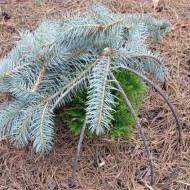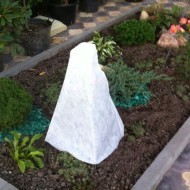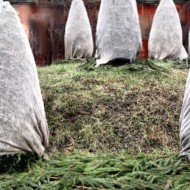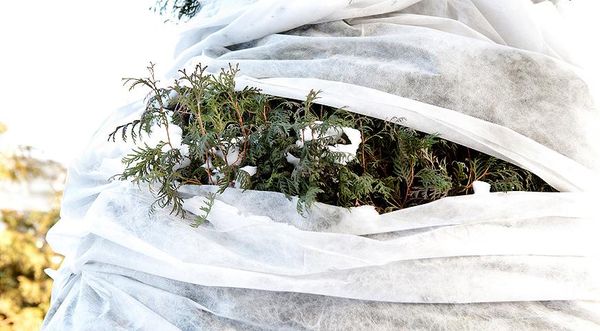How to cover conifers for the winter without the risk of freezing
Content
Reasons for hiding
Conifers occupy a special place in the hearts of avid summer residents. Evergreen trees and shrubs are planted not only as an element of the garden composition, but also as an independent plant. The needles shade the area well, add coziness to the overall picture of the summer cottage. Even in the cold season, when all plants go into so-called hibernation, coniferous plantations are a kind of decoration, suggesting winter holidays in a warm family circle.
The main reasons for the shelter of coniferous crops for the winter are the frosty wind and the scorching rays of the sun. These are the factors that have the most adverse effect on plants. The sun's rays are especially dangerous during thaw periods. At this time, the coniferous tree evaporates a large amount of moisture, which is not replenished in any way. It's all about the stay of the tree in a state of rest and the absence of sap flow. It was during this period that the rays of the sun not only completely dry the branches, but also leave severe burns on them. Frosty wind is no less harmful for conifers. That is why many summer residents plant their spruces, thujas and pines along the wall or surrounded by other plants. This to some extent protects the seedlings from the wind.
Video "Preparing for the winter of conifers"
From this video you will learn how to properly prepare conifers for the winter period.
Protection for medium-sized species
Medium-sized conifers and shrubs include thuja, certain varieties of yew, spruce, pine, cedar, cypress, and fir. The first point in the process of warming these crops is the bending of the branches to the trunk. To fasten the legs, use an ordinary twine, which is not tightly wrapped around the ephedra. After that, a special agrotextile insulation cover is put on the plant, which can be found in specialized gardening stores. If this is not possible, you can prepare the insulation yourself. To do this, take a non-woven material, wrap a coniferous tree with it, and fix the seams with a stapler.
It is important to remember that pines and spruces need additional insulation only in the first year of life. If the branches of the coniferous culture are very fragile, they should not be bent down. In this case, a frame of wooden bars or plastic mesh is built around the plant. It is better not to use wire when preparing the frame, as it conducts cold well and will only aggravate the situation. When the bars are installed, they are wrapped with a special insulation material.
The gardener can choose from:
- agrospana;
- agrofibre;
- spunbond;
- burlap;
- lutrasila;
- kraft paper.
Polyethylene is not used as a covering material, as it accumulates moisture, which can provoke rotting of a garden pet.
Safety measures for low-growing shrubs
Unlike medium-sized coniferous species, undersized varieties require less care before wintering. For their warming, gardeners of the middle lane often use spruce or pine branches. They are located around the bush, forming a kind of pyramid.If we are talking about a region with a more severe climate, where the temperature drops to -20 ° C, the plant is additionally covered with plastic containers. The soil in the root zone of young bushes is slightly huddled and mulched with sawdust.
Other care procedures
Preparing conifers for winter includes the following stages:
- Watering. The soil is moistened half a meter deep not only at the trunk, but also within the radius of the root system. If autumn is rainy, watering is excluded, otherwise the plant may rot.
- Mulching. For this procedure, organic materials are used: hay, tree bark, sawdust, needles, spruce branches. The mulch layer should be thin, otherwise the risk of rodents will increase.
- Top dressing. This is an important step in caring for a plant in the fall. The fertilizer will saturate the ephedra with substances necessary for a safe wintering. In addition, the autumn feeding is a kind of catalyst for the spring growth of the plant. For fertilization of crops, compost, vermicompost, a mixture of dolomite flour and magnesium are used. Mixtures containing nitrogen are excluded, because they activate vital processes in the plant, which slow down in the cold season.
- Shelter. Insulation methods depend on the climatic features of the area and the type of ephedra. Caring for frost-hardy conifers in the fall includes fixing the branches with twine. This will protect them from damage caused by strong winds. More delicate varieties of coniferous crops need autumn insulation. However, any gardener should observe the measure in this matter, since excessive wrapping can only harm the root system and the plant as a whole.
They remove the shelter with the arrival of spring, preferably in cloudy weather. If damaged, dry branches are found or the plant has faded, a number of "reanimating" procedures are carried out:
- spraying with warm water;
- sun protection;
- processing of crowns of shrubs and trees with biostimulants.
Conifers are rightfully considered one of the most unpretentious and non-capricious garden crops. In the warm season, they may well take care of themselves, but with the arrival of winter, the attention and responsibility of the gardener become necessary.
Summer residents who take care of their bushes and trees receive healthy and fragrant conifers as a token of gratitude.





